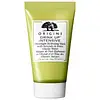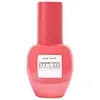What's inside
What's inside
 Key Ingredients
Key Ingredients

 Benefits
Benefits

 Concerns
Concerns

 Ingredients Side-by-side
Ingredients Side-by-side

Water
Skin ConditioningGlycerin
HumectantCetyl Alcohol
EmollientGlyceryl Polymethacrylate
Niacinamide
SmoothingHydroxyethyl Urea
HumectantPEG-75
HumectantDimethicone
EmollientPersea Gratissima Oil
Skin ConditioningPPG-15 Stearyl Ether
EmollientPEG-8
HumectantGlycereth-26
HumectantSorbitan Stearate
EmulsifyingCitrus Aurantium Amara Leaf/Twig Oil
MaskingCitrus Aurantium Dulcis Peel Oil
MaskingRicinus Communis Seed Oil
MaskingOsmanthus Fragrans Flower Extract
MaskingRosa Damascena Extract
MaskingRibes Nigrum Bud Extract
PerfumingCinnamomum Camphora Leaf Extract
MaskingBenzaldehyde
MaskingHexenyl Acetate
MaskingGamma-Decalactone
PerfumingIonone
AstringentEthyl Acetate
PerfumingAlcohol
AntimicrobialLinalool
PerfumingLimonene
PerfumingIsopropyl Isostearate
EmollientPEG-100 Stearate
Citrus Aurantium Dulcis Peel Wax
Skin ConditioningPrunus Armeniaca Kernel Oil
MaskingMangifera Indica Seed Butter
Skin ConditioningSucrose
HumectantHypnea Musciformis Extract
Skin ProtectingAvena Sativa Kernel Extract
AbrasiveTriticum Vulgare Bran Extract
Skin ConditioningCladosiphon Okamuranus Extract
Skin ConditioningCetearyl Alcohol
EmollientCaffeine
Skin ConditioningOryza Sativa Extract
AbsorbentGelidiella Acerosa Extract
Skin ProtectingButylene Glycol
HumectantAloe Barbadensis Leaf Extract
EmollientPantethine
EmollientOlea Europaea Fruit Extract
BleachingCocos Nucifera Oil
MaskingPunica Granatum Sterols
Skin ConditioningSorbitol
HumectantCaprylyl Glycol
EmollientTocopheryl Acetate
AntioxidantOryzanol
Skin ConditioningTrehalose
HumectantBisabolol
MaskingCetyl Ethylhexanoate
EmollientSodium Hyaluronate
HumectantCarbomer
Emulsion StabilisingHexylene Glycol
EmulsifyingPotassium Hydroxide
BufferingDextrin
AbsorbentDisodium EDTA
Potassium Sorbate
PreservativePhenoxyethanol
PreservativeAquilaria Agallocha Wood Oil
MaskingWater, Glycerin, Cetyl Alcohol, Glyceryl Polymethacrylate, Niacinamide, Hydroxyethyl Urea, PEG-75, Dimethicone, Persea Gratissima Oil, PPG-15 Stearyl Ether, PEG-8, Glycereth-26, Sorbitan Stearate, Citrus Aurantium Amara Leaf/Twig Oil, Citrus Aurantium Dulcis Peel Oil, Ricinus Communis Seed Oil, Osmanthus Fragrans Flower Extract, Rosa Damascena Extract, Ribes Nigrum Bud Extract, Cinnamomum Camphora Leaf Extract, Benzaldehyde, Hexenyl Acetate, Gamma-Decalactone, Ionone, Ethyl Acetate, Alcohol, Linalool, Limonene, Isopropyl Isostearate, PEG-100 Stearate, Citrus Aurantium Dulcis Peel Wax, Prunus Armeniaca Kernel Oil, Mangifera Indica Seed Butter, Sucrose, Hypnea Musciformis Extract, Avena Sativa Kernel Extract, Triticum Vulgare Bran Extract, Cladosiphon Okamuranus Extract, Cetearyl Alcohol, Caffeine, Oryza Sativa Extract, Gelidiella Acerosa Extract, Butylene Glycol, Aloe Barbadensis Leaf Extract, Pantethine, Olea Europaea Fruit Extract, Cocos Nucifera Oil, Punica Granatum Sterols, Sorbitol, Caprylyl Glycol, Tocopheryl Acetate, Oryzanol, Trehalose, Bisabolol, Cetyl Ethylhexanoate, Sodium Hyaluronate, Carbomer, Hexylene Glycol, Potassium Hydroxide, Dextrin, Disodium EDTA, Potassium Sorbate, Phenoxyethanol, Aquilaria Agallocha Wood Oil
Water
Skin ConditioningMethylpropanediol
SolventC9-12 Alkane
SolventFragaria Vesca Fruit Extract
AstringentHydroxypropyl Starch Phosphate
Salicylic Acid
MaskingPentylene Glycol
Skin ConditioningMandelic Acid
AntimicrobialSuccinic Acid
BufferingFragaria Vesca Leaf Extract
AstringentAzelaic Acid
BufferingAllantoin
Skin ConditioningSodium Hyaluronate
HumectantBisabolol
MaskingOpuntia Ficus-Indica Flower Extract
Skin ConditioningNiacinamide
SmoothingGlucosamine
Zingiber Officinale Root Extract
MaskingSaccharomyces Ferment
Skin ConditioningDextrin
AbsorbentPolydextrose
Humectant1,2-Hexanediol
Skin ConditioningCaprylyl Glycol
EmollientCoco-Caprylate/Caprate
EmollientHydroxyacetophenone
AntioxidantAmylopectin
Butylene Glycol
HumectantSuccinoglycan
Skin ConditioningLeuconostoc/Radish Root Ferment Filtrate
AntimicrobialLauroyl Lysine
Skin ConditioningSodium Phytate
Lecithin
EmollientAminomethyl Propanol
BufferingXanthan Gum
EmulsifyingCitric Acid
BufferingParfum
MaskingWater, Methylpropanediol, C9-12 Alkane, Fragaria Vesca Fruit Extract, Hydroxypropyl Starch Phosphate, Salicylic Acid, Pentylene Glycol, Mandelic Acid, Succinic Acid, Fragaria Vesca Leaf Extract, Azelaic Acid, Allantoin, Sodium Hyaluronate, Bisabolol, Opuntia Ficus-Indica Flower Extract, Niacinamide, Glucosamine, Zingiber Officinale Root Extract, Saccharomyces Ferment, Dextrin, Polydextrose, 1,2-Hexanediol, Caprylyl Glycol, Coco-Caprylate/Caprate, Hydroxyacetophenone, Amylopectin, Butylene Glycol, Succinoglycan, Leuconostoc/Radish Root Ferment Filtrate, Lauroyl Lysine, Sodium Phytate, Lecithin, Aminomethyl Propanol, Xanthan Gum, Citric Acid, Parfum
 Reviews
Reviews

Ingredients Explained
These ingredients are found in both products.
Ingredients higher up in an ingredient list are typically present in a larger amount.
Bisabolol is famous for its skin soothing properties. It does this by blocking inflammatory signals, helping to reduce your body's reaction to irritation.
This ingredient also interferes with the process of hyperpigmentation. This can help with reducing dark spots and uneven tone.
Bisabolol is an antioxidant. Antioxidants help fight free-radicals. Free-radicals are molecules that may damage your skin cells. By fighting these free-radicals, Bisabolol may slow down signs of aging.
Studies have shown Bisabolol to have antimicrobial properties and may be a fungicide. These properties help preserve a product's shelf life.
All these properties makes bisabolol a great skin barrier helper ingredient.
Bisabolol also helps the absorption of other ingredients.
Note: Synthetic Bisabolol has been shown to be less effective.
Learn more about BisabololButylene Glycol (or BG) is used within cosmetic products for a few different reasons:
Overall, Butylene Glycol is a safe and well-rounded ingredient that works well with other ingredients.
Though this ingredient works well with most skin types, some people with sensitive skin may experience a reaction such as allergic rashes, closed comedones, or itchiness.
Learn more about Butylene GlycolCaprylyl Glycol is a humectant and emollient, meaning it attracts and preserves moisture.
It is a common ingredient in many products, especially those designed to hydrate skin. The primary benefits are retaining moisture, skin softening, and promoting a healthy skin barrier.
Though Caprylyl Glycol is an alcohol derived from fatty acids, it is not the kind that can dry out skin.
This ingredient is also used as a preservative to extend the life of products. It has slight antimicrobial properties.
Learn more about Caprylyl GlycolDextrin is used to thicken a product and helps bind ingredients together. It is created from starch and glycogen.
As an emulsifier, dextrin prevents ingredients from separating. This helps elongate a product's shelf life.
Studies show coating UV filters with dextrin prevents these ingredients from being absorbed. This helps UV ingredients last longer on the skin.
Learn more about DextrinNiacinamide is a multitasking form of vitamin B3 that strengthens the skin barrier, reduces pores and dark spots, regulates oil, and improves signs of aging.
And the best part? It's gentle and well-tolerated by most skin types, including sensitive and reactive skin.
You might have heard of "niacin flush", or the reddening of skin that causes itchiness. Niacinamide has not been found to cause this.
In very rare cases, some individuals may not be able to tolerate niacinamide at all or experience an allergic reaction to it.
If you are experiencing flaking, irritation, and dryness with this ingredient, be sure to double check all your products as this ingredient can be found in all categories of skincare.
When incorporating niacinamide into your routine, look out for concentration amounts. Typically, 5% niacinamide provides benefits such as fading dark spots. However, if you have sensitive skin, it is better to begin with a smaller concentration.
When you apply niacinamide to your skin, your body converts it into nicotinamide adenine dinucleotide (NAD). NAD is an essential coenzyme that is already found in your cells as "fuel" and powers countless biological processes.
In your skin, NAD helps repair cell damage, produce new healthy cells, support collagen production, strengthen the skin barrier, and fight environmental stressors (like UV and pollution).
Our natural NAD levels start to decline with age, leading to slower skin repair, visible aging, and a weaker skin barrier. By providing your skin niacinamide, you're recharging your skin's NAD levels. This leads to stronger, healthier, and younger looking skin.
Another name for vitamin B3 is nicotinamide. This vitamin is water-soluble and our bodies don't store it. We obtain Vitamin B3 from either food or skincare. Meat, fish, wheat, yeast, and leafy greens contain vitamin B3.
The type of niacinamide used in skincare is synthetically created.
Learn more about NiacinamideSodium Hyaluronate is hyaluronic acid's salt form. It is commonly derived from the sodium salt of hyaluronic acid.
Like hyaluronic acid, it is great at holding water and acts as a humectant. This makes it a great skin hydrating ingredient.
Sodium Hyaluronate is naturally occurring in our bodies and is mostly found in eye fluid and joints.
These are some other common types of Hyaluronic Acid:
Learn more about Sodium HyaluronateWater. It's the most common cosmetic ingredient of all. You'll usually see it at the top of ingredient lists, meaning that it makes up the largest part of the product.
So why is it so popular? Water most often acts as a solvent - this means that it helps dissolve other ingredients into the formulation.
You'll also recognize water as that liquid we all need to stay alive. If you see this, drink a glass of water. Stay hydrated!
Learn more about Water